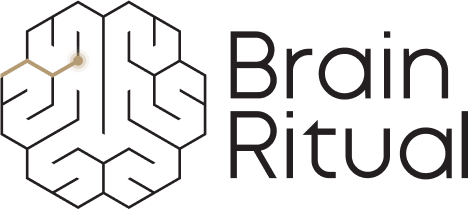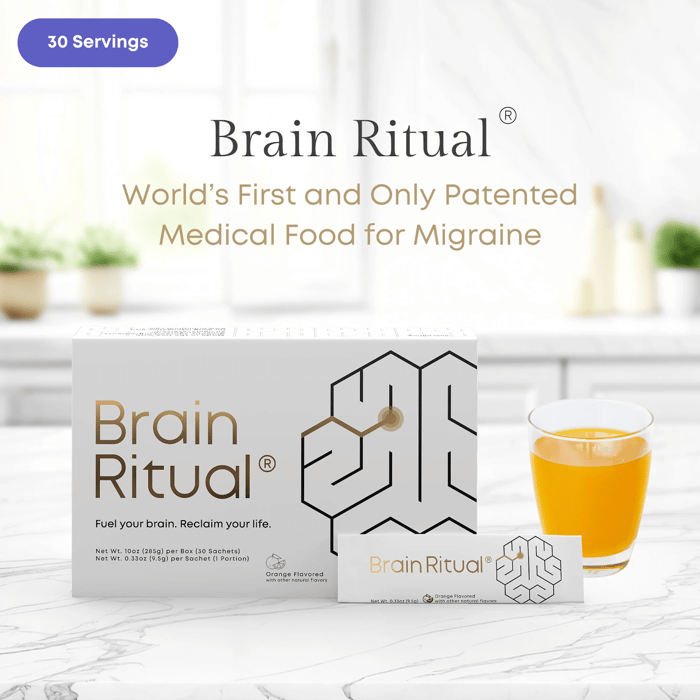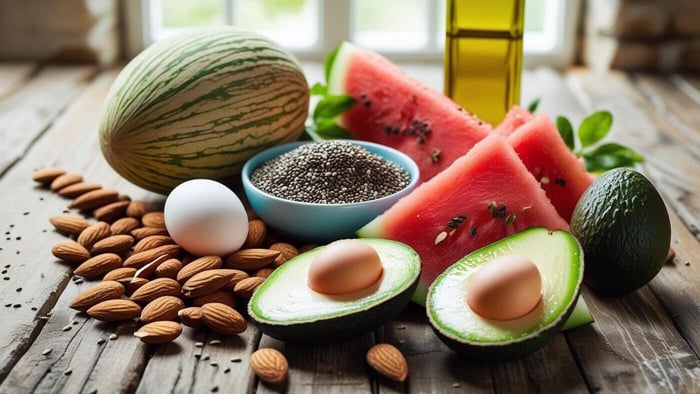Table of Contents
At a Glance
|
If you're reading this, chances are you’ve felt a migraine coming on after something you’ve eaten. Maybe it’s that creeping headache after a glass of wine, the brain fog after a takeaway, the sudden pressure after a square of dark chocolate, or the mystery migraine that seems to arrive after lunch but never quite in the same way twice.
It's frustrating. And while not every food is a trigger, for many people with migraine, diet seems to have much more of an impact than they first realized.
The truth is, migraine is deeply individual. One person might react to red wine or aged cheese, while someone else can eat both with no issues at all.
That said, certain dietary patterns and ingredients show up more often in people’s trigger histories. While these aren’t hard rules, being aware of them may help if you're trying to reduce the likelihood of an episode.
This migraine foods to avoid list walks through a range of everyday items that may act as dietary triggers for some people.
They’re grouped by the underlying mechanisms they may affect, such as inflammation or brain energy supply. Whether you’re newly diagnosed or trying to fine-tune your eating routine, this list is here to help you make informed choices without feeling too restricted.
If you're also interested in what foods to add to your diet that may support brain health and migraine resilience, you may want to explore our Foods That Help with Migraines guide for practical, brain-friendly meal ideas.
Migraine Foods to Avoid – Quick Summary Table
| Category | Examples | Why They May Be a Problem |
| Aged & Fermented Foods | Aged cheese, cured meats, sauerkraut, soy sauce | High in histamine, may worsen inflammation |
| Processed Snacks & Flavors | Instant noodles, flavored crisps, MSG-heavy takeaways | Contain additives like MSG and flavor enhancers |
| Sugary & Refined Carbs | Pastries, white bread, soda, sweet cereals | May spike blood sugar and disrupt brain energy |
| Dairy | Milk, yogurt, cheese, cream | May contain casein or lactose, which can trigger inflammation or sensitivities in some individuals |
| High-Lectin Plant Foods | Tomatoes, beans, lentils, some nightshades | Contain compounds that may trigger inflammation |
| Overripe or Citrus Fruits | Bananas (ripe), oranges, lemons | Natural compounds may act as triggers in some people |
| Caffeine, Alcohol & Chocolate | Red wine, beer, energy drinks, excess coffee, chocolate | Can affect blood flow, brain chemistry, hydration, or trigger oxidative stress and withdrawal symptoms |
| Other Possible Triggers | Nuts (esp. walnuts, peanuts), pickled items, sweeteners, large fish (e.g., tuna) | May contain histamine, mold, artificial ingredients, or environmental toxins |
Now let’s take a closer look at each category, exploring why certain foods might be tricky for people with migraine and how to feel more in control of your food choices.
Migraine Foods to Avoid: A Closer Look at Common Dietary Triggers
Aged & Fermented Foods
Examples: Aged cheese, cured meats like salami or prosciutto, sauerkraut, miso, soy sauce, and vinegar-based condiments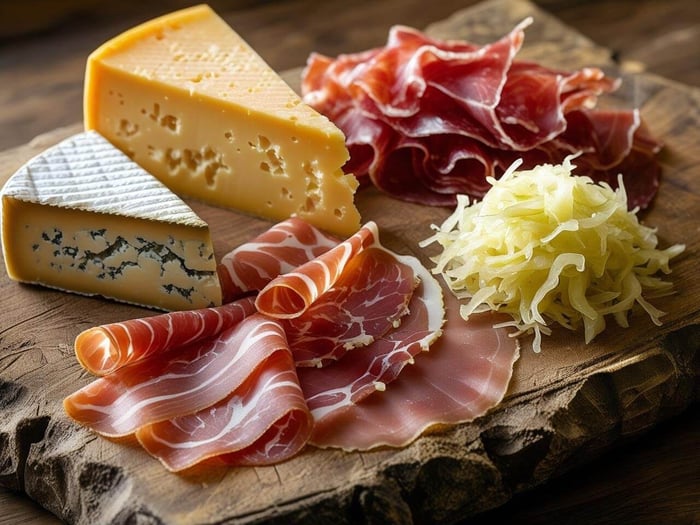
Although these foods are rich in flavor, they’re often high in histamine too. Histamine is a natural compound involved in the immune response, where it plays a helpful role in defending against allergens or injury. Unfortunately, excess levels can also contribute to migraine symptoms in some people.
Some of these foods also contain other compounds, such as tyramine or nitrates; these may play a role in migraine symptoms for some people, especially when combined with other factors like poor sleep, stress, or alcohol.
Histamine levels in aged and fermented foods tend to rise over time due to the way these products are processed or stored. This gradual buildup can make these foods more problematic when eaten frequently or in combination with other common migraine triggers.
People with migraine may also have difficulty breaking down excess histamine, particularly if key nutrients like vitamin B2 or magnesium are lacking. This can increase sensitivity, especially when multiple dietary and lifestyle pressures stack up at the same time.
What to keep in mind
You don’t need to avoid these foods completely, but being aware of how often they appear and in what combinations can make a difference. Aged and fermented foods offer plenty of flavor, but they also come with compounds that may be harder for some people with migraine to process. Paying attention to your own response over time may provide the clearest insight into what works for you.
If you’re exploring nutritional strategies to help manage histamine sensitivity, Brain Ritual® includes key nutrients like vitamin B6, magnesium, riboflavin, zinc, and choline to help support histamine metabolism, neurological balance, and cellular resilience.
Overripe or Citrus Fruits
Examples: Bananas (especially overripe), oranges, lemons, limes, grapefruit, and dried fruit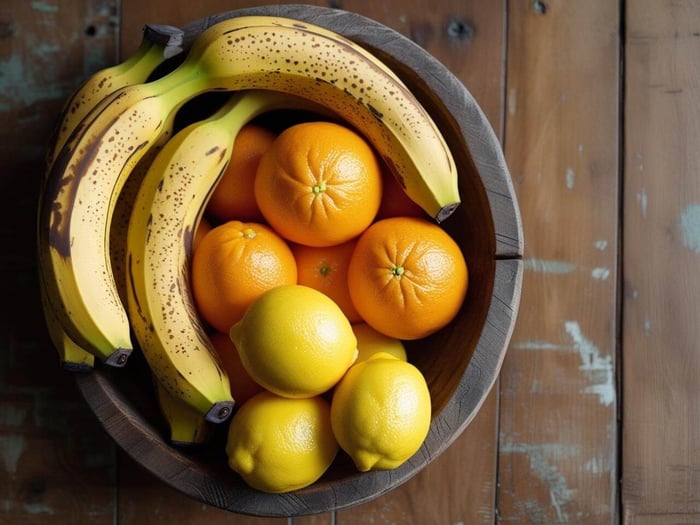
While fruit is usually seen as part of a healthy lifestyle, some types of citrus and overripe fruits may act as potential triggers for people with migraine.
In overripe bananas, the concentration of compounds such as tyramine increases as the fruit ripens. Tyramine has been linked to migraine in some individuals, especially when consumed in larger amounts or alongside other dietary stressors such as caffeine, aged cheese, or skipped meals. These factors may also impact blood vessels or brain chemistry by influencing things like blood flow, neurotransmitter release, or vascular tone.
Citrus fruits like oranges, lemons, and grapefruit are naturally high in histamine or contain compounds that may trigger histamine release in the body. For people already sensitive to histamine, this could further contribute to symptoms, especially when combined with other histamine-rich or trigger-prone foods such as aged meats, fermented products, or red wine.
Fruit-based products like dried fruit, candied peel, or citrus-flavored drinks often contain preservatives such as sulfites, which may add to the overall trigger load in people who are already sensitive.
Even though fruit is an important part of a healthy diet, if you tend to experience symptoms after eating oranges, bananas, or fruit-heavy desserts, it may be worth experimenting with alternatives and noting whether it affects how you feel.
What to keep in mind
If you suspect certain fruits might be contributing to symptoms, try paying attention to how ripe they are and whether they tend to appear alongside other triggers. Swapping overly ripe or high-histamine fruits for gentler options such as berries, melon, or apples may provide a more migraine-friendly choice.
Processed Snacks & Flavors
Examples: Instant noodles, flavored crisps, stock cubes, packaged sauces, and MSG-heavy takeaways
Highly processed snacks and convenience foods might be comforting or easy to grab on a busy day, but they’re often packed with ingredients that may be problematic for people with migraine.
One such ingredient is monosodium glutamate (MSG), a flavor enhancer found in many savory packaged foods. While its reputation has been debated, some people with migraine report that it contributes to symptoms like pressure or dizziness, particularly when combined with other known migraine triggers.
Processed foods often contain preservatives, artificial sweeteners, synthetic flavorings, emulsifiers, and refined oils. These ingredients may disrupt normal brain signaling, promote inflammation, or affect gut, hormonal, and metabolic balance in people who are more sensitive to dietary triggers.
Furthermore, many of these products are known to spike blood sugar levels quickly, which may create additional instability for those prone to migraine.
Not everyone reacts to processed foods in the same way, but regularly eating them can make it harder to identify potential triggers or maintain a consistent, brain-supportive baseline.
What to keep in mind
You don’t have to eliminate all processed foods, but it can help to check labels for potentially troublesome ingredients and take note of how often these foods show up. Making small adjustments to your eating habits may help if symptoms tend to follow. Over time, this kind of awareness can reveal patterns that might otherwise go unnoticed.
Gluten-Containing Grains
Examples: Wheat bread, pasta, crackers, cakes, pastries, and many baked goods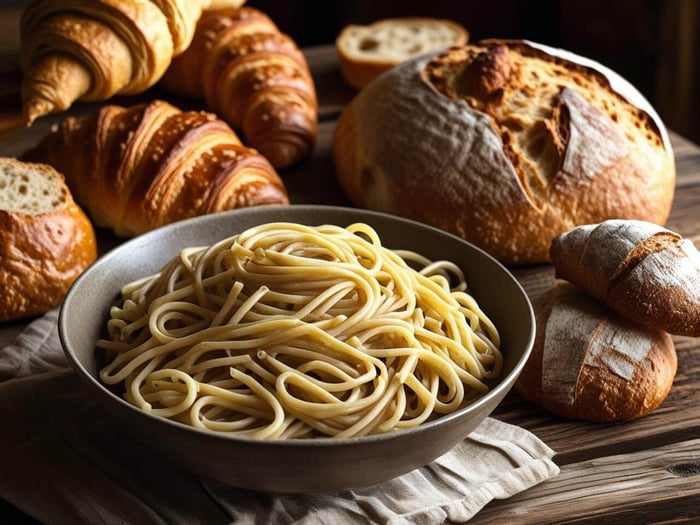
Gluten-containing grains such as wheat, barley, and rye are a common part of many diets, but they may be problematic for some people with migraine.
While gluten itself isn’t considered a universal trigger, some people report an improvement in symptoms after reducing or removing it from their diets, even without a formal diagnosis of celiac disease or gluten intolerance.
Many gluten-containing products are highly processed and low in fiber. This can affect blood sugar balance, digestion, inflammation, and oxidative stress, all of which may play a role in migraine susceptibility. In people who are sensitive, gluten or wheat proteins may also contribute to gut irritation or immune activation, both of which could influence migraine risk through the gut-brain axis.
It’s also worth noting that gluten-containing foods often appear alongside other potential triggers, like added sugar, preservatives, and refined oils. This can make it difficult to know whether gluten is the issue, or simply part of a broader dietary pattern that isn’t migraine-friendly.
If symptoms tend to follow meals high in bread, pasta, or baked goods, it may be worth experimenting with alternatives and noting how you feel.
What to keep in mind
If you suspect gluten may be contributing to symptoms, consider reducing how often you eat wheat-based staples and observing any changes. Naturally gluten-free options like rice or quinoa may offer a gentler alternative, without the need for strict exclusion. Just keep in mind that many gluten-free substitutes are still highly processed and may include additives of their own.
Dairy products
Examples: Milk, yogurt, cream, soft cheeses (like ricotta or cottage cheese), hard cheeses (like cheddar or parmesan), and butter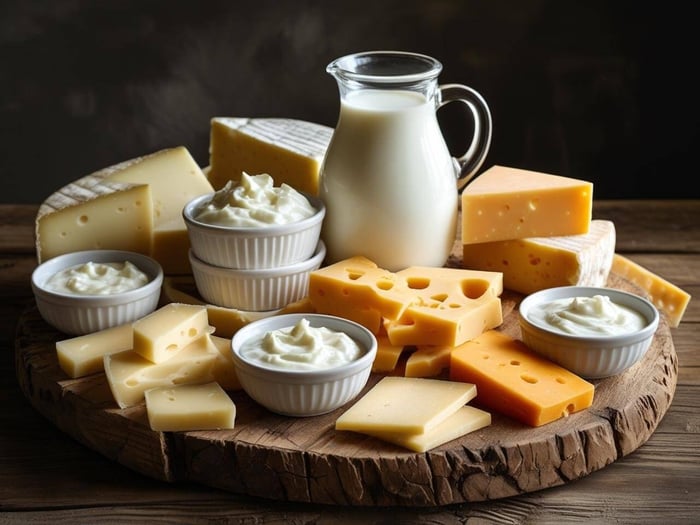
Although dairy is a rich source of nutrients and protein, it may pose challenges for people with migraine. Proteins found in dairy, such as casein, can provoke inflammatory responses or sensitivities in susceptible individuals.
The sugar lactose, which is naturally present in milk, may upset digestion. This can influence the gut-brain axis and potentially contribute to migraine risk.
Aged cheeses tend to contain higher levels of histamine due to fermentation and aging. This can increase the likelihood of triggering migraine symptoms, especially in people who have difficulty breaking down histamine effectively.
Some dairy products contain bioactive hormones or growth factors that might play a subtle role in inflammation and vascular changes, although more research is needed to fully understand their impact in the context of migraine.
What to keep in mind
Completely removing dairy isn’t always necessary, but paying close attention to how different dairy products affect you can be helpful. Some people tolerate yogurt or lactose-free options well, while others do better by cutting back or skipping dairy completely.
Ghee is generally the best tolerated dairy product, as it neither contains casein, nor lactose. Trying dairy free versions of milks (like coconut) and yogurts is also a good way to find out whether dairy is an issue. At least a four-week trial without dairy is needed to determine whether it’s an issue for you.
Choosing sheep and goat’s milk derived dairy products can help as well, as this contains a different form of casein that can be better tolerated. Raw milk products have unchanged casein, which for some people also makes a difference.
If histamine of fermented dairy is an issue, pairing dairy with foods rich in vitamin B2 (riboflavin) and magnesium, which are included in the medical food Brain Ritual®, may support histamine breakdown and help maintain inflammatory balance.
High-Lectin Plant Foods
Examples: Tomatoes, bell peppers, kidney beans, lentils, chickpeas, soy, peanuts, and other legumes or nightshades

Lectins are naturally occurring proteins found in many plants, especially legumes and nightshades such as tomatoes, potatoes, and eggplants. While they serve as a defense mechanism for the plant, some people may find lectins irritating to the gut lining or immune system, particularly when these foods are eaten frequently or when legumes are consumed without proper preparation, such as soaking or cooking.
For people with migraine, this kind of gut-level irritation may be relevant. The gut-brain axis plays a role in both inflammation and neurological signaling. In sensitive individuals, lectins may contribute to symptoms by increasing digestive stress or triggering low-grade immune responses.
Lectin-containing foods like beans, lentils, and tomatoes also frequently appear in processed meals, canned soups, and fast foods, where they’re often combined with other migraine-unfriendly ingredients like added sugar, refined oils, and preservatives.
Not everyone with migraine reacts to lectin-rich foods, but if symptoms seem to follow meals that heavily feature beans, tomato sauces, or soy-based ingredients, it may be worth experimenting with a lower-lectin approach.
What to keep in mind
If you suspect lectins may be contributing to symptoms, consider reducing your intake of beans, lentils, or nightshades for a short time and monitoring how you feel.
Soaking, sprouting, or pressure-cooking legumes can significantly reduce their lectin content and may make them easier to tolerate if you’d prefer not to cut them out completely.
Sugary & Refined Carbohydrates
Examples: Pastries, soda, sweetened breakfast cereals, white bread, and packaged desserts
Refined carbohydrates show up in all kinds of everyday foods, from breakfast cereals and pastries to sweetened coffee drinks, sodas, and fast foods. While these options might offer a quick energy boost, eating them often leads to sharp spikes and crashes in blood sugar and insulin levels. For people with migraine, this kind of energy instability may prove problematic.
Rapid changes in blood sugar levels can place extra stress on the brain’s energy systems, which are thought to function differently in people with migraine. Refined carbs also tend to lack fiber, protein, and healthy fats. These nutrients help slow digestion and support more stable energy levels throughout the day.
Many sweetened or processed products also include artificial colors, flavorings, or sweeteners, which may add to the overall load in people sensitive to multiple dietary inputs.
Not everyone with migraine is affected by sugar in the same way, but a heavy reliance on sweetened or highly refined foods may make it harder to maintain stable energy levels throughout the day and pinpoint which aspects of your diet could be making symptoms more likely.
What to keep in mind
There’s no need to avoid every sweet or refined food, but being mindful of how you incorporate them into your diet can make a difference. Combining refined carbohydrates with protein or healthy fats may help moderate blood sugar swings and improve energy stability.
For those looking to support more stable brain energy, Brain Ritual® includes nutrients like CoQ10, magnesium, B vitamins, and L-carnitine, along with R-3-hydroxybutyrate salts, a ketone-based energy source that helps fuel brain cells when glucose levels are unstable. Together, these ingredients help fuel mitochondrial function and reduce energy dips that may contribute to migraine vulnerability.
Caffeinated Beverages & Chocolate
Examples: Coffee, black tea, energy drinks, colas, chocolate bars, and cocoa-based desserts
Caffeine is a bit of a paradox when it comes to migraine. For some people, small amounts can offer temporary relief, especially at the onset of an attack. But for others, overuse or inconsistent intake may act as a trigger, particularly if it leads to withdrawal or sudden spikes in consumption.
Caffeine has an impact on blood vessels, influencing their tone and ability to constrict or dilate, which can affect migraine susceptibility. It also affects brain chemistry by modulating neurotransmitters like adenosine, which may play a role in migraine thresholds. Skipping your usual cup of coffee or tea, or having an extra one during a stressful day, can sometimes be enough to increase the risk of symptoms.
Chocolate often comes up in the migraine conversation because it contains both caffeine and small amounts of tyramine, along with other naturally occurring compounds that may stimulate the nervous system. Some people report cravings for chocolate just before a migraine begins, making it difficult to tell whether it’s a true trigger or part of the early symptom pattern.
It’s also worth noting that many chocolate-based products contain added sugar, dairy, and preservatives, which can add to the overall trigger load. Cocoa content may also play a role. Milk chocolate tends to contain more sugar and additives, while dark chocolate has a higher cocoa concentration and may be more stimulating for some, though others find it easier to tolerate.
What to keep in mind
If you suspect caffeine or chocolate may be playing a role in your migraine, try tracking how much you consume and whether your intake is consistent. Reducing large fluctuations in caffeine consumption, rather than cutting it out entirely, may be more helpful for maintaining stability.
As for chocolate, try smaller portions or opt for simpler, lower-sugar varieties, and consider whether dark chocolate feels more tolerable than milk-based options.
Alcohol
Examples: Red wine, white wine, beer, champagne, cocktails, and mixed spirits

Alcohol is one of the most commonly reported dietary migraine triggers, though not everyone with migraine is affected in the same way. Red wine tends to be mentioned most often, but other types of alcohol, including beer and mixed drinks, may also be problematic.
There’s no single component in alcohol that’s clearly to blame. It may be a combination of factors: histamine and sulfites in wine, congeners in darker spirits, or simply the way alcohol affects dehydration, sleep quality, blood vessels, and brain chemistry. In some people, alcohol can also impact serotonin levels, which may contribute to delayed or “hangover-like” migraines and headaches the next day.
Alcohol is also frequently consumed with other potential triggers such as aged cheeses, processed meats, or sugar-heavy mixers, which can make it hard to pinpoint the true cause of symptoms.
What to keep in mind
If alcohol seems to play a role in your migraine, try paying attention to the type, the amount, and what else you’re eating or drinking at the same time. Some people find that small amounts of spirits or low-sulfite wine are better tolerated than beer or red wine, but individual responses vary widely. Staying hydrated, eating beforehand, and avoiding known food triggers may also help reduce your risk.
Other Possible Food Triggers
Examples: Walnuts, peanuts, pickled items, artificial sweeteners, canned fish, tuna, smoked meats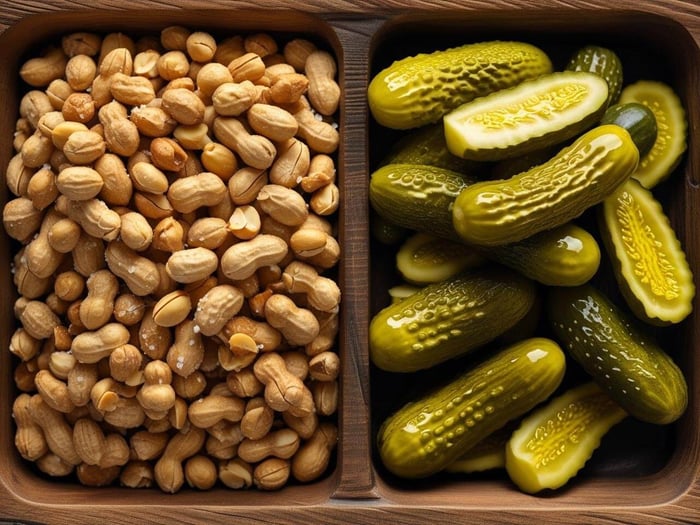
Not every potential migraine trigger fits neatly into a major food category, but a few other common culprits are worth keeping an eye on.
Nuts, especially peanuts and walnuts, are sometimes reported as migraine triggers, possibly due to their natural content of amines or from mold exposure during storage.
Pickled and fermented foods, like kimchi or gherkins, can be high in histamine or preservatives that may contribute to symptoms in sensitive individuals.
Artificial sweeteners, such as aspartame, are included in some sugar-free products and may disrupt brain signaling or metabolism in people who are already vulnerable to dietary triggers.
Finally, large fish species such as tuna or mackerel can accumulate environmental toxins like mercury and may also contain increased levels of histamine when not properly stored or processed.
What to keep in mind
This category can feel unpredictable, but you don’t have to avoid all these foods outright. If symptoms tend to follow certain snack items, condiments, or processed proteins, try noting their specific ingredients and how often they appear. Looking at your diet as a whole may help uncover patterns that aren’t obvious from one meal alone.
FAQs: Migraine Triggers Foods to Avoid
What is histamine, and why does it matter for people with migraine?
Histamine is a naturally occurring compound involved in immune responses and regulating functions like digestion and blood flow. Some foods, especially aged, fermented, or citrus-based ones, either contain histamine or trigger its release in the body.
People with migraine may have difficulty breaking down excess histamine, which can contribute to inflammation, nerve irritation, or changes in blood vessel tone that increase migraine risk.
What is tyramine, and how is it linked to migraine?
Tyramine is a byproduct of protein breakdown, found in aged or overripe foods like mature cheese, cured meats, and bananas.
It may affect blood vessel constriction and dilation, which can influence brain chemistry and trigger migraine in sensitive individuals. Tyramine is also structurally similar to neurotransmitters like norepinephrine, which may explain why it impacts some people more than others.
Can artificial sweeteners trigger migraine symptoms?
Some people with migraine report sensitivity to artificial sweeteners like aspartame, which is found in sugar-free gums, diet sodas, and low-calorie desserts.
Aspartame may alter levels of neurotransmitters such as serotonin or interfere with normal energy metabolism in the brain. The evidence is mixed, but it may be worth experimenting with alternatives if symptoms seem to follow consumption of sweetened products.
Why are sulfites included in the list of potential triggers?
Sulfites are preservatives used in some wines, dried fruits, and packaged foods to extend shelf life.
In sensitive individuals, sulfites may trigger respiratory symptoms or vascular changes that overlap with migraine mechanisms. While not everyone is affected, people who experience reactions to wine or dried fruits might consider choosing lower-sulfite or preservative-free options.
How do changes in blood sugar and brain energy relate to migraine?
The brain relies on a steady supply of energy to function properly. Sudden changes in blood sugar, especially sharp drops caused by sugary snacks, skipping meals, or high-glycemic foods, can stress the brain’s energy systems and may act as a trigger for migraine.
Some people with migraine may also have altered glucose metabolism or mitochondrial dysfunction. Since mitochondria help generate energy in nearly all cells, including those in the brain, anything that disrupts their performance, such as unstable blood sugar or oxidative stress, may reduce the brain’s ability to cope with triggers.
Looking for Nutritional Support?If you’re working to reduce migraine risk through diet, especially in response to known food triggers, nutritional strategies may offer an added layer of support. Brain Ritual® was developed by an Oxford-trained neuroscientist for the dietary management of migraine, under medical supervision. It combines 35 foundational nutrients like magnesium, riboflavin (B2), CoQ10, and B6 with ingredients not commonly found in typical migraine supplements. These include:
Together, these ingredients are designed to support mitochondrial health, nervous system stability, healthy inflammatory responses, and more consistent brain energy — all in a simple daily formula. Discover Brain Ritual® and see if it’s right for you. |
Final Thoughts
Food isn’t the only factor in migraine, but for many people, it plays a bigger role than expected. This guide isn’t meant to give you a strict list of “good” and “bad” foods, but is designed to help you notice patterns, ask the right questions, and explore your own responses with more clarity and confidence.
If a particular food consistently triggers symptoms for you, it makes sense to limit or avoid it. But in many cases, it’s the combination of foods, timing, stress, sleep, and hydration that makes the difference. Try looking at your diet as a whole and stay open to gradual, thoughtful changes rather than cutting out everything on this list at once.
Above all, this is about supporting your brain, not restricting your lifestyle. Even small shifts in how you approach food can help you feel more in control of your symptoms and more at ease with the choices you make every day.
